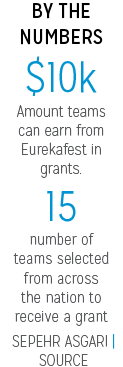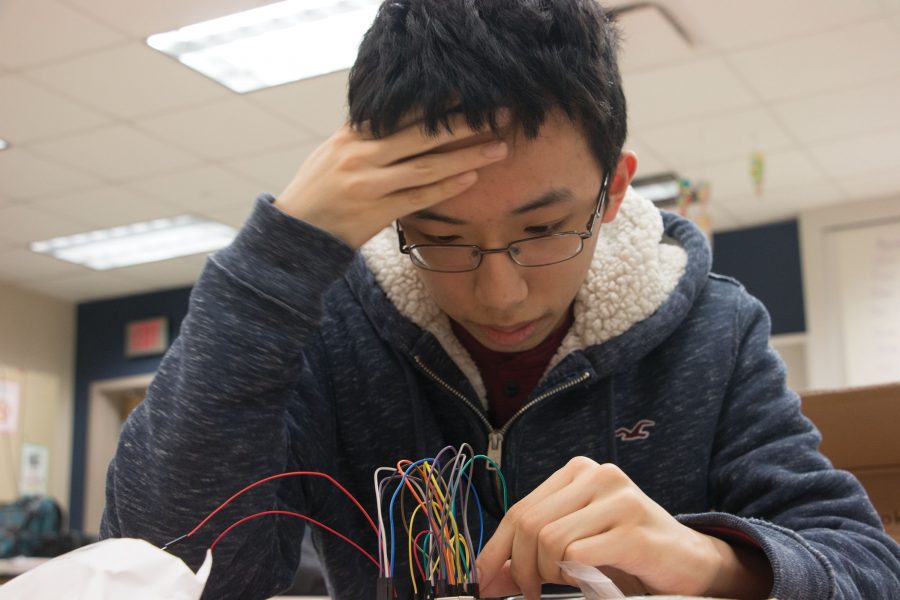 This year CHS InvenTeam has been selected to be one of the 15 teams from around the country to receive the prestigious InvenTeam grant. The InvenTeam is program is offered by Lemelson-MIT an organization that is the cooperation between the Lemelson Foundation and MIT. InventTeams are groups of high school students who, if selected, receive up to $10,000 to fund their invention and can travel to MIT to show it off at “Eurekafest.”
This year CHS InvenTeam has been selected to be one of the 15 teams from around the country to receive the prestigious InvenTeam grant. The InvenTeam is program is offered by Lemelson-MIT an organization that is the cooperation between the Lemelson Foundation and MIT. InventTeams are groups of high school students who, if selected, receive up to $10,000 to fund their invention and can travel to MIT to show it off at “Eurekafest.”
Eurekafest is a multiple day event, where the InvenTeams from around the country meet to show off their inventions. “EurekaFest is a celebration of the inventive spirit,” said Anthony Perry, Invention Education Associate at Lemelson-MIT. “InvenTeams from across the country will present and showcase their working prototypes to the public, see presentations from the 2017 Student Prize Competition winners, and take place in other fun activities to celebrate their accomplishments.”
The CHS InvenTeam started out as the vision of club president and sophomore, Sepehr Asgari. According to Asgari, forming an invention club has been a dream of his ever since middle school. During his freshman year of high school he decided to make that dream a reality. “Sepher and I, we were in English class, and we were just musing over an idea of starting a club,” said Tony Ou, head of testing team and sophomore, “We decided to take a shot at it because it sounded like fun, so we started the club.”
The CHS team will be making a device to help people with epilepsy. More specifically the device will use electromyography, a technique that detects the electrical signals sent to muscles, to detect “status epilepticus” and inject medicine to treat it. According to the US National Library of Medicine, status epilepticus is when a seizure either lasts too long or multiple seizures occur consecutively, a serious condition that may cause death. One of the reasons the team decided on seizure detection was because they wanted to help people with epilepsy. “I have a personal connection with someone who is affected by the disease,” said Cameron Poulsen, head of public relations and junior, “it is definitely a motivation to help her and just spread awareness about this form of epilepsy in general.”
Before CHS InvenTeam goes to Eurekafest, they will need to complete a working prototype of their invention. According to Satvik Kumar, head of injection team and sophomore, the club plans to create many prototypes, focussing the first one purely on function, but then working to make the device smaller, more effective, and more convenient with the following models. On top of the detection and injection devices, they will also be building a testing device, as Lemelson-MIT prohibits any testing on live subjects.
One way that the team will be working on their prototype is by taking apart mechanisms for other products. More specifically, the injection team is looking at objects that use spring motion to see if they can base the design of their injection device off of them. “We basically had a brainstorming where we were looking at how we could get this done, and someone had the genius idea of using a camera shutter mechanism,” said Kumar, “that is why we have been taking apart a camera to see how the springs, and how the mechanism works inside of that.”
One challenge that the team is dealing with is the accessibility of the information that can be found about their topic. “There is a lot of past precedents, so a lot of the work we do is concerning research, researching schematics that have been done beforehand so we can get a better idea of what to do,” said Ou. “The problem is, a lot of these schematics are a tad bit advanced so we have to research the things that we research. We research until we know exactly what to do and then we build it.”
Even after CHS’s team goes to Eurekafest, they still hope to continue development of the project. Because the InvenTeam program ensures that neither MIT nor Lemelson owns the rights to a project, the team can choose to turn their invention into an actual business. “If it does end up working out well, the students could file for a patent,” Jacob Fitzgerald, InvenTeam cosponsor and biology teacher said, “they could then own the rights to that idea for a certain number of years, and other people would have to come to them to potentially fund it.”
Even if the team does not patent the device in the end, Fitzgerald still feels they serve to benefit from the experience. “I feel like they are going to have a sense of accomplishment, regardless of what happens because it is just them doing the research, just them doing the building and stuff like that. They are solving a real world problem, at the age of 14 through 16 years old, which is incredible.”































![What happened to theater etiquette? [opinion]](https://hilite.org/wp-content/uploads/2025/04/Entertainment-Perspective-Cover-1200x471.jpg)














































![Review: “The Immortal Soul Salvage Yard:” A criminally underrated poetry collection [MUSE]](https://hilite.org/wp-content/uploads/2025/03/71cju6TvqmL._AC_UF10001000_QL80_.jpg)
![Review: "Dog Man" is Unapologetically Chaotic [MUSE]](https://hilite.org/wp-content/uploads/2025/03/dogman-1200x700.jpg)
![Review: "Ne Zha 2": The WeChat family reunion I didn’t know I needed [MUSE]](https://hilite.org/wp-content/uploads/2025/03/unnamed-4.png)
![Review in Print: Maripaz Villar brings a delightfully unique style to the world of WEBTOON [MUSE]](https://hilite.org/wp-content/uploads/2023/12/maripazcover-1200x960.jpg)
![Review: “The Sword of Kaigen” is a masterpiece [MUSE]](https://hilite.org/wp-content/uploads/2023/11/Screenshot-2023-11-26-201051.png)
![Review: Gateron Oil Kings, great linear switches, okay price [MUSE]](https://hilite.org/wp-content/uploads/2023/11/Screenshot-2023-11-26-200553.png)
![Review: “A Haunting in Venice” is a significant improvement from other Agatha Christie adaptations [MUSE]](https://hilite.org/wp-content/uploads/2023/11/e7ee2938a6d422669771bce6d8088521.jpg)
![Review: A Thanksgiving story from elementary school, still just as interesting [MUSE]](https://hilite.org/wp-content/uploads/2023/11/Screenshot-2023-11-26-195514-987x1200.png)
![Review: "When I Fly Towards You", cute, uplifting youth drama [MUSE]](https://hilite.org/wp-content/uploads/2023/09/When-I-Fly-Towards-You-Chinese-drama.png)
![Postcards from Muse: Hawaii Travel Diary [MUSE]](https://hilite.org/wp-content/uploads/2023/09/My-project-1-1200x1200.jpg)
![Review: "Ladybug & Cat Noir: The Movie," departure from original show [MUSE]](https://hilite.org/wp-content/uploads/2023/09/Ladybug__Cat_Noir_-_The_Movie_poster.jpg)
![Review in Print: "Hidden Love" is the cute, uplifting drama everyone needs [MUSE]](https://hilite.org/wp-content/uploads/2023/09/hiddenlovecover-e1693597208225-1030x1200.png)
![Review in Print: "Heartstopper" is the heartwarming queer romance we all need [MUSE]](https://hilite.org/wp-content/uploads/2023/08/museheartstoppercover-1200x654.png)



